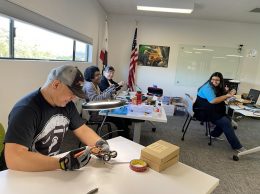Digital West wiring SLO at the speed of light
IN THIS ARTICLE
- Technology Topic
- Stephen Nellis Author
By Stephen Nellis Monday, December 27th, 2010
The telecommunications firm Digital West is working to make its hometown of San Luis Obispo the best-connected city in the Tri-Counties.
Digital West is ringing the town with its own high-speed fiber lines, bringing speeds to Central Coast businesses that aren’t available in many parts of the Tri-Counties.
It has a 90,000-square-foot data center in the works that would draw twice as much power as the entire Cal Poly San Luis Obispo campus. And it is working on building on-ramps and off-ramps to the three trans-Pacific Internet backbone cables that come ashore in San Luis Obispo County and head to San Francisco and Los Angeles.
For most businesses, a fiber-optic network is about 10 times faster than copper-based networks. Verizon, which didn’t return an interview request by the press deadline for this story, has rolled out fiber in some of Ventura County. But in many areas of the Tri-Counties, the fastest available Internet connection remains a T1 or similar high-bandwidth copper line through a cable provider.
“They’re not in San Luis Obispo or Santa Barbara and probably won’t be for a long time,” Digital West CEO Tim Williams told the Business Times. “The carriers pick densely populated areas where they can get the most bang for their buck.”
Digital West has become what’s known as an interexchange carrier, a regulatory status that lets it do things a utility would, such as lay fiber cabling underground or on aboveground poles. Its first big fiber project was bringing higher speeds to the county government.
Since then, Digital West has laid four miles of fiber along Broad Street, from near San Luis Obispo’s airport to near downtown. The firm hopes to penetrate the downtown area in the first quarter of next year and then march toward Buckley Road, where it will be within striking distance of its original installation.
“We’d have a complete ring that goes all the way around the city,” Williams said.
To make the financials pencil out, Williams is signing up interested businesses before the fiber is laid. A U.S. Small Business Administration-backed loan funded the first phases.
“It’s an expensive endeavor for us to do this,” Williams said. “The big guys aren’t coming here for a reason — there isn’t a density of businesses that makes it cost-effective.”
So far, Digital West has signed up tech firms such as Mindbody Online and Level Studios, two businesses that generate a lot of jobs and revenue without any local customers.
Another tool Williams has used is collaboration. He’s waited until the county, Cal Poly or Charter Communications were doing work in an area and then joined up with them.
“It’s a lot easier to put in four conduits at once than to put in one,” he said.
San Luis Obispo-based TekTegrity said it’s ready for fiber. “We’re in the city of San Luis Obispo, and I cannot get Charter cable here. That’s how sporadic high-speed Internet is,” said Jeremy Koellish, the chief operating officer of the firm.
TekTegrity manages many of its clients’ computers and networks remotely. That means better connectivity is better business. “We live and die by being connected to the Internet. Having higher speed Internet for us creates greater efficiency and greater profitability,” Koellish said.
In addition to laying its own local fiber, Digital West is in talks to tap the trans-Pacific Internet pipes that come from Asia to the U.S. and land on the Central Coast. There are three that hit the shore near San Luis Obispo. “It’s like a highway from the beach coming from the east, and there’s really no off-ramp — it just goes north and south,” Williams said. “What we’ll do is have that highway accessible right here.”
To really take advantage of those on-ramps and off-ramps, Digital West wants to have a state-of-the-art data center ready and waiting for firms that want a straight shot to Asia. It currently operates a 2,000-square-foot data center, and it is in escrow on a building near the San Luis Obispo airport that it wants to turn into a 90,000-square-foot center.
“We need to find a place that’s big enough that we’ll never have to move again,” Williams said, adding that he is in talks with PG&E over getting enough electricity to power such a center.
Koellish of TekTegrity said the investments that Digital West is making on the Central Coast now bode well for San Luis Obispo’s future. It has turned the city’s isolation from major metropolitan areas into an asset, he said.
“I don’t think they would be able to pull this off in San Francisco or Los Angeles — there’s huge competition,” Koellish said. “But the isolation we have has given a local company the chance to do it. In the long run, it will attract more companies to this beautiful place where we live. It could potentially turn us more into a tech hub.”
Are you a subscriber? If not, sign up today for a four-week FREE trial or subscribe and receive the Book of Lists free with your purchase.











